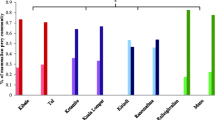Abstract
Recently ecological data on spider and howler monkeys at Tikal, Guatemala, have been used in an attempt to demonstrate that primate populations are not limited by food resources. Those data are shown here to be inadequate for testing hypotheses about population limitation, and the problem of discerning limiting factors is explored.
Similar content being viewed by others
References
Altmann, J., S. A. Altmann, G. Hausfater, &S. A. McCluskey, 1977. Life history of yellow baboons: physical development, reproductive parameters, and infant mortality.Primates, 18: 315–330.
Andrewartha, H. G. &L. C. Birch, 1954.The Distribution and Abundance of Animals. Univ. of Chicago Press, Chicago.
Bramblett, C. A., 1976.Patterns of Primate Behavior. Mayfield, Palo Alto.
Cant, J. G. H., 1977a. Ecology, locomotion, and social organization of spider monkeys (Ateles geoffroyi). Ph.D. Thesis, Univ. of California, Davis.
----, 1977b. Ecology of spider monkeys (Ateles geoffroyi) at Tikal, Guatemala.Paper presented at Ann. Meet. Amer. Anthropol. Ass., Houston.
----, 1978a. Reproductive strategies of spider monkeys (Ateles geoffroyi).Paper presented at 47th Ann. Meet. Amer. Ass. Phys. Anthropol., Toronto.
————, 1978b. Population survey of the spider monkeyAteles geoffroyi at Tikal, Guatemala.Primates, 19: 525–535.
Charles-Dominique, P. &C. M. Hladik, 1971. LeLepilemur de Sud du Madagascar: écologie, alimentation et vie sociale.Terre et Vie, 25: 3–66.
Clutton-Brock, T. H., 1977. Methodology and measurement. In:Primate Ecology: Studies of Feeding and Ranging Behaviour in Lemurs, Monkeys and Apes,T. H. Clutton-Brock (ed.), Academic Press, New York, pp. 585–590.
Cody, M. L., 1974.Competition and the Structure of Bird Communities. Princeton Univ. Press, Princeton.
Coelho, A. M., C. A. Bramblett, &L. B. Quick, 1977. Social organization and food resource availability in primates: a socio-bioenergetic analysis of diet and disease hypotheses.Am. J. Phys. Anthropol., 46: 253–264.
————, ————, ————, 1976. Resource availability and population density in primates: Socio-bioenergetic analysis of energy budgets of Guatemalan howler and spider monkeys.Primates, 17: 63–80.
————, 1977. Ecology, population characteristics, and sympatric association in primates: a socio-bioenergetic analysis of howler and spider monkeys in Tikal, Guatemala.Yrbk. Phys. Anthropol., 20: 96–135.
Dittus, W. P. J., 1977. The social regulation of population density and age-sex distribution in the toque monkey.Behaviour, 63: 281–322.
Foster, R. B., 1974. Seasonality of fruit production and seed fall in a tropical forest ecosystem in Panama. Ph.D. Thesis, Duke Univ., Durham, North Carolina.
Frisch, R. E. &J. W. McArthur, 1974. Menstrual cycles: fatness as a determinant of minimum weight for height necessary for their maintenance or onset.Science, 185: 949–951.
Glander, K. E., 1975. Habitat description and resource utilization: a preliminary report on mantled howling monkey ecology. In:Socioecology and Psychology of Primates,R. H. Tuttle (ed.), Mouton, The Hague, pp. 37–57.
Klein, L. L. &D. J. Klein, 1975. Social and ecological contrasts between four taxa of neotropical primates. In:Socioecology and Psychology of Primates,R. H. Tuttle (ed.), Mouton, The Hague, pp. 59–85.
Lack, D., 1954.The Natural Regulation of Animal Numbers. Clarendon Press, Oxford.
Mittermeier, R. A., 1977. Distribution, synecology and conservation of Surinam monkeys. Ph.D. Thesis, Harvard Univ., Cambridge, Massachusetts.
Puleston, D. E. 1968.Brosimum alicastrum as a subsistence alternative for the classic Maya of the central southern lowlands. M.A. Thesis, Univ. of Pennsylvania, Philadelphia, Pennsylvania.
————, 1973. Ancient Maya settlement patterns and environment at Tikal: Implications for subsistence models. Ph.D. Thesis, Univ. of Pennsylvania, Philadelphia, Pennsylvania.
Schoener, T. W., 1974. Resource partitioning in ecological communities.Science, 185: 27–39.
Struhsaker, T. T., 1973. A recensus of vervet monkeys in the Masai-Amboseli Game Reserve, Kenya.Ecology, 54: 930–932.
————, 1976. A further decline in numbers of Amboseli vervet monkeys.Biotropica, 8: 211–214.
Wiens, J. A., 1977. On competition and variable environments.Am. Sci., 65: 590–597.
Wrangham, R. W., 1977. Feeding behaviour of chimpanzees in Gombe National Park, Tanzania. In:Primate Ecology: Studies of Feeding and Ranging Behaviour in Lemurs, Monkeys and Apes,T. H. Clutton-Brock (ed.), Academic Press, New York, pp. 504–538.
Author information
Authors and Affiliations
About this article
Cite this article
Cant, J.G.H. What limits primates?. Primates 21, 538–544 (1980). https://doi.org/10.1007/BF02373842
Received:
Accepted:
Issue Date:
DOI: https://doi.org/10.1007/BF02373842




